Have you seen the astounding movie “Finding Nemo”? If you’re familiar with it, you also know “Dory,” a captivating blue tang fish.
The Blue Tang, also known as the Palette Surgeonfish (Paracanthurus hepatus), is a tropical marine fish belonging to the family Acanthuridae. It is one of the most popular aquarium fishes, and its vibrant coloration makes it a beautiful addition to any aquascape.
There are so many queries about this small aquatic creature. And here, I am going to answer each of them in detail. So, read the whole article till the last.
Blue Tang Fish: At a Glance
| Category | Information |
| Common Name | Blue tang fish |
| Scientific Name | Paracanthurus hepatus |
| Family | Acanthuridae |
| Size | Up to 30 cm (12 in) in length |
| Weight | Up to 600 g (1.3 lb) |
| Lifespan | 30 years in wild |
| Diet | Omnivores, but primarily herbivorous |
| Habitat | Coral reefs and rocky crevices |
| Distribution | Tropical and subtropical waters of the Atlantic, Indian, and Pacific Oceans |
| Reproduction | Broadcast Spawning Method |
| Conservation Status | Least Concern (IUCN) |
The Blue Tang Fish, also known as the Palette Surgeonfish or the Regal Tang, is a species of tropical marine fish native to the reefs of the Indo-Pacific Ocean. It has an oval shape, a deep blue body, and a yellow tail fin. The paler fins and their black edges are striking against the bright blue coloration of this fish’s body. This vibrant coloring makes them a popular choice for home aquariums.
The Blue Tang Fish is an active swimmer who enjoys swimming in open water instead of staying close to coral reefs or rocks. They feed on algae, plankton, tiny crustaceans, and other small organisms found in their environment. They typically aggregate in groups during feeding time, which is usually during dawn or dusk.
Blue Tangs are social creatures that often form large schools for protection and communication purposes. These schools can be anywhere from 10 to several hundred individual fish in size and they bring a kaleidoscope of color to the reef ecosystem.
They reproduce through spawning with two adults releasing eggs and sperm into the water at once before quickly dispersing so any predators don’t get them.
Fun Facts about The Blue Tang Fish
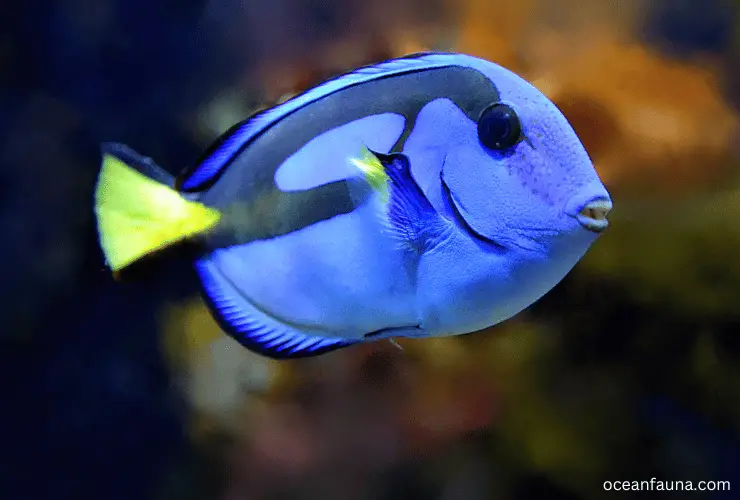
1. The blue tang fish, also known as the regal tang or palette surgeonfish, is a species of fish found mainly in tropical waters of the Atlantic Ocean and Indo-Pacific region.
2. Blue Tangs have vibrant colors that vary depending on their age, ranging from bright yellow to a deep royal blue.
3. The blue tang fish has a distinctive deep-blue tail, which is used as an escape mechanism when threatened by predators.
4. Blue Tangs have small, sharp spines on their body that contain toxins that can cause pain and irritation if touched.
5. Blue tang’s flesh is poisonous, so humans can’t consume them.
6. The blue tang fish is listed as “Least Concern” on the International Union for Conservation of Nature’s (IUCN) Red List of Threatened Species.
7. Blue Tangs are omnivores and their diet consists mainly of plankton, algae, benthic invertebrates, and small fish.
8. Blue Tangs form large schools in the wild and can reach up to a size of 30 centimeters (12 inches).
9. The character “Dory” from the “Finding Nemo” movie was a blue tang fish.
10. Blue Tangs are considered a hardy fish species well suited for life in captivity as long as proper care is provided.
Anatomy of Blue Tang Fish
Skeletal System
Blue tangs have a well-developed skeleton that includes the skull, backbone, rib cage, and pelvic girdle, among other bones. Most of their bones comprise cartilage instead of bone tissue due to their evolutionary adaptation for swimming efficiently through the water. Their spines are very flexible, which lets them move quickly when chasing prey or getting away from them.
Muscular System
The muscular system helps move the blue tang by contracting skeletal muscles. They have both white muscle fibers (for quick movements) and red muscle fibers (for sustained swimming). These muscles give them extra power when they need to dart away from predators or catch prey quickly.
Circulatory System
The circulatory system consists of a four-chambered heart that pumps oxygenated blood throughout the fish’s body via arteries and veins. Oxygen is delivered through gills located on either side of the head which extract oxygen from the surrounding water as they pass over them while swimming or resting underwater.
Respiratory System
As previously mentioned, blue tangs use their gills to extract oxygen from their environment for respiration purposes. They also have specialized organs called swim bladders which help them control buoyancy to swim up or down from different depths in the ocean more easily.
Digestive System
The digestive system starts at the mouth, where food goes in, and ends at the anus, where waste leaves the body.
Inside this tube are several vital organs, like the teeth for chewing, the stomach for breaking down food into usable compounds, the intestines for absorbing nutrients into the bloodstream, the liver for helping the digestion process, and the gallbladder for storing bile made by liver cells that are used in the fat digestion process, etc.
Excretory System
The blue tang’s excretory system gets rid of metabolic wastes like urea and ammonia. This is done by special organs called kidneys, which are in the lower part of the abdomen cavity near its backside and tailfin.
The kidneys produce a liquid that looks like urine after a filtration process, which is done with the help of looping ureters. This liquid is then taken out of the body through the cloaca, which is below the ventral surface and near the front.
Nervous System
Compared to other fish, blue tangs have more complicated nervous systems. Their brains have a lot of nerve cells all over their bodies, and their eyes have a special layer of retinal cells that help them find light sources. These cells act like receptors that tell them when something changes in their environment, so they can react quickly and stay safe.
How Big Is a Blue Tang Fish?
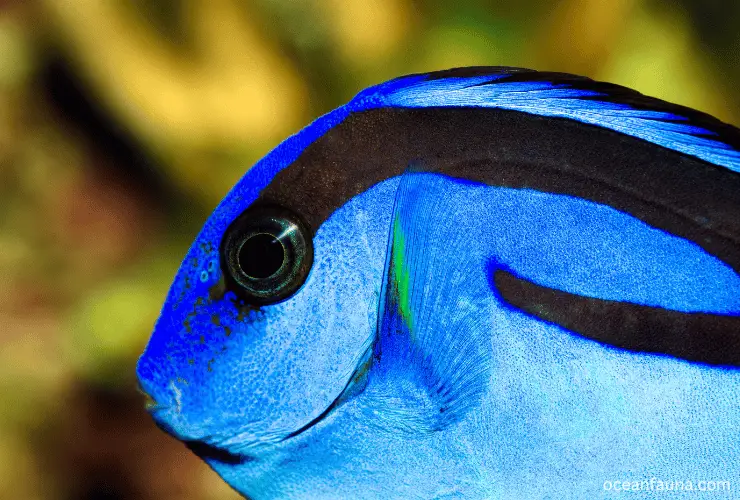
Regarding size, adult blue tangs typically reach lengths of 10-12 inches (25-30 centimeters) from snout to tail. The maximum reported length is 15.8 inches (40 centimeters), although such instances are quite rare as they are usually smaller.
Weighing around 1.3 pounds (600 grams) on average, these fish display sexual dimorphism, meaning that males are generally larger than females. The disparity in size between the two genders is an evolutionary adaptation that helps to increase reproductive success.
The body of a blue tang fish is laterally compressed, which means it is flat and narrow from side to side. This sleek body shape enables the fish to maneuver easily through the complex coral reef systems which they call home.
Additionally, their oval-like shape and tapered tail allow for a quick burst of speed if they need to evade predators or pursue prey.
The blue tang’s striking coloration adds to its appeal and serves a functional purpose in its natural habitat. The bright blue body allows the fish to blend in with the sunlit waters above the reef, making it less visible to predators from below.
Conversely, the darker shades of blue on their upper bodies help camouflage them against the shadowy reef backdrop, protecting them from predators above.
Where Do Blue Tang Fish Live?
Blue tangs live in coral reefs and inshore rocky areas in the Indo-Pacific Ocean and the western Atlantic Ocean. In the Indo-Pacific Ocean, blue tangs can be found from Japan to Australia, the Philippines to New Caledonia, Sri Lanka to Samoa, and East Africa.
They are abundant in the western Atlantic Ocean from New York and Bermuda to the Gulf of Mexico, south to Brazil, and Ascension Island. They typically inhabit depths of 6-131 feet, where they make their homes in small crevices and holes on the reef for protection from predators.
Blue tangs prefer warm waters with temperatures ranging from 75°F-83°F (24°C – 28°C). They also have a high amount of tolerance for salinity levels making them somewhat adaptable to different environments.
In addition to living in the wild, blue tangs are also kept as aquarium fish. As an omnivorous fish species, aquarists must provide a balanced diet containing both plant matter and protein sources for sustained health.
As reef fish, blue tangs need plenty of swimming room and many hiding spots from rocks or coral structures. Tank mates should be carefully chosen since blue tangs can become aggressive when paired with more territorial species, such as clownfish or damsels.
What Do Blue Tang Fish Eat?
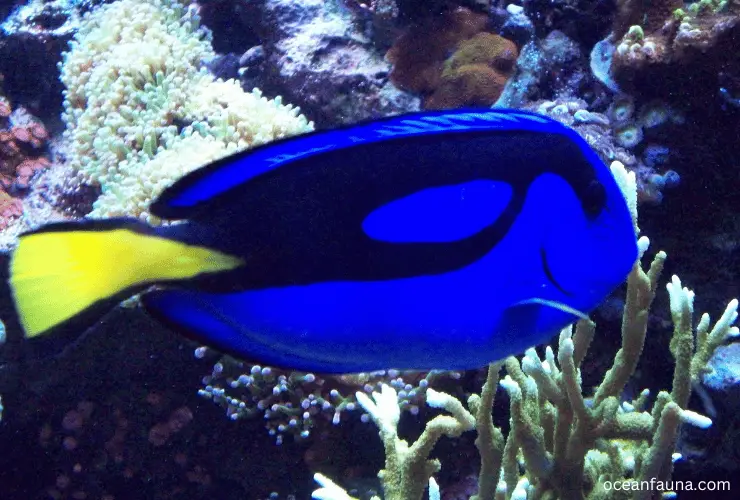
Blue tang fish are primarily herbivorous marine creatures that depend on a diverse and nutritionally dense diet to thrive in their natural habitat. Although they are classified as omnivorous, their diet consists mainly of plant and algae materials, making herbivorous items their primary food source.
One of the primary food sources for blue tang fish is marine algae, which contains essential nutrients needed for their health and growth.
Specifically, they consume various types of marine algae such as red, green, and brown algae. These algae are abundant in the underwater ecosystem and are crucial contributors to the overall health of coral reefs, where blue tang fish are found.
In addition to algae, blue tang fish consume small aquatic invertebrates such as brine shrimp, which serve as a source of protein in their diet.
They also feed on copepods, tiny crustaceans that provide essential nutrients and contribute to their overall well-being. Like phytoplankton and other microscopic organisms, Zooplankton is also part of their omnivorous diet.
Furthermore, blue tang fish occasionally eat small bits of seaweed and detritus, which usually have some nutritional value. They also consume small amounts of other plant materials that they can find in their aquatic environment.
In captivity, such as in a zoo or an aquarium, blue tang fish are provided with a balanced diet that closely mimics their natural food sources. Chopped squid and capelin are often included in their diet to ensure they receive an adequate amount of protein. Vegetables such as broccoli and peas are also provided to supplement their herbivorous tendencies.
Maintain a diverse and nutritious diet for blue tang fish, as their overall health and vitality are dependent on it. Inadequate nutrition can lead to concerns like poor growth, a weakened immune system, and susceptibility to diseases.
A proper diet and an appropriate and clean environment ensure that blue tang fish can thrive and maintain their vibrant colors and energetic personalities.
What Is the Lifespan of Blue Tang Fish?
The lifespan of blue tang fish can vary depending on their environment. Blue tangs can live up to 30 years or more in the wild. The exact age that a fish will reach depends on its health and environmental conditions, such as water temperature and quality.
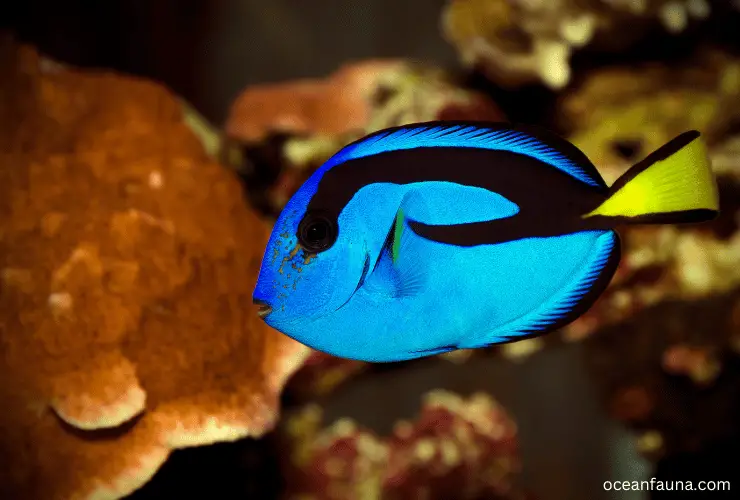
In aquariums, blue tangs generally survive for about 8 to 12 years due to the increased likelihood of diseases and a less ideal environment than in their natural habitat.
However, with proper care, some individuals have been documented living longer than 20 years in captivity. To ensure a healthy lifespan, it is crucial to provide them with a large enough tank, high-quality water conditions, plenty of space to swim and play, and a diet rich in vitamins.
Furthermore, regular monitoring for disease symptoms is essential to ensure their best possible health so they can experience a long life in your aquarium.
How Do Blue Tang Fish Reproduce?
Blue tang fish reproduce through a fascinating process called broadcast spawning. This reproduction method is common among various species of reef fish and is particularly well-suited to the blue tang’s natural habitat in coral reefs.
In broadcast spawning, multiple females and males simultaneously release their respective gametes, which are eggs and sperm, into the open water column above the reef.
This mass spawning event typically occurs during specific environmental conditions like lunar cycles, water temperature, and tides to ensure the highest chance of reproductive success. Such conditions help synchronize the reproductive activities of blue tangs living close.
During the spawning process, the female blue tangs produce numerous tiny, buoyant eggs that are rich in yolk. Each female can release hundreds to thousands of eggs per spawning event, resulting in many potential offspring.
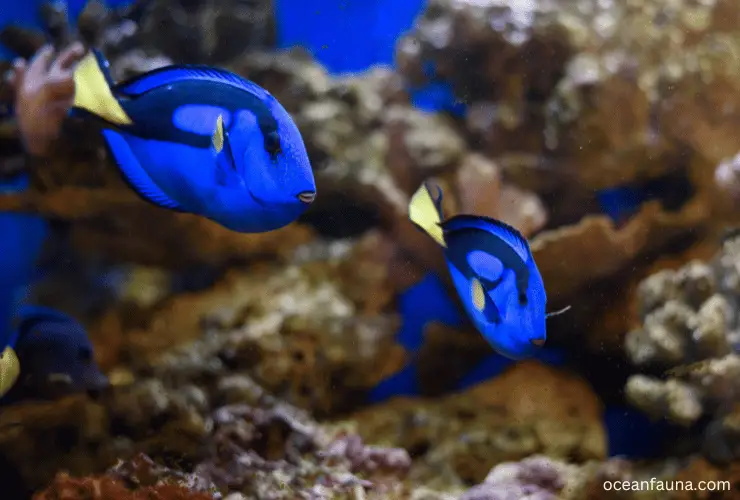
Conversely, the males release a vast number of sperm cells into the water, ensuring a greater chance of fertilization. When the sperm and eggs come into contact in the water column, fertilization takes place.
The fertilized eggs then drift through the water column as part of the plankton, where water currents disperse them. This dispersion increases the chances of survival by minimizing the likelihood of predation and competition for resources. It also ensures that the offspring will settle in various locations, broadening the gene pool and promoting genetic diversity among blue tang populations.
Blue tang eggs typically hatch within 24-48 hours of being fertilized. Once they hatch, the baby blue tangs, or larvae, continue to float among the plankton, developing and growing until they reach the juvenile stage. Juvenile blue tangs can then settle into a coral reef habitat, where they continue to mature into adults.
Is a Blue Tang Fish Venomous?
Yes, blue tangs are venomous. Despite their seemingly gentle appearance, these fish possess a hidden and fascinating self-defence mechanism. Situated on either side of their tails are specialized spines known as “scalpels,” which are not only razor-sharp but also laced with venom. Blue tangs primarily employ this natural weapon when faced with potential threats or predators.
Blue tangs can quickly raise these venomous spines upon sensing danger, creating an effective and menacing line of defence. To further deter predators, the fish will vigorously oscillate their bodies from side to side, brandishing their toxin-coated stingers.
When a predator gets stabbed by one of these venomous spines, they experience severe pain and tissue damage.
The venom secreted by blue tangs is a proteinaceous substance, and its potency varies from one individual to another. While it is not lethal to humans, it can still cause significant pain, swelling, and in some cases, an allergic reaction.
Consequently, humans should exercise caution when handling or encountering blue tangs in the wild or in captivity.
In addition to their remarkable defensive mechanism, blue tangs boast a vibrant blue coloration, further contributing to their ability to ward off potential predators.
This coloration is an example of ‘aposematism,’ a biological phenomenon wherein conspicuous markings or colorations warn predators, indicating that the animal possesses a chemical or physical defence mechanism that would cause harm.
What Happens If a Blue Tang Stings You?
If a blue tang stings you, it can lead to several unpleasant symptoms and consequences. The sting occurs when the fish extends its sharp caudal spines, which are located on either side of its caudal peduncle – the narrow area that connects the main body and the tail. These spines contain toxins that can cause severe pain and irritation upon contact.
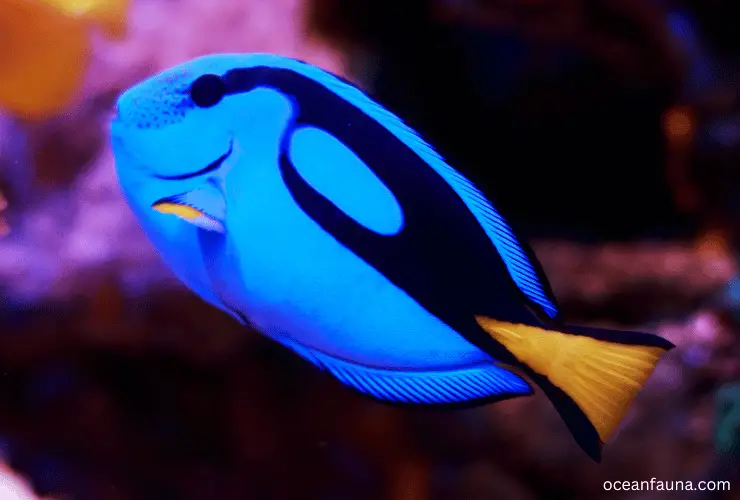
Once stung by a blue tang, the person may immediately experience a sudden, sharp, and intense pain at the site of the sting. This pain is caused by the toxins released from the fish’s caudal spine penetrating the skin.
The toxins can vary in terms of potency and may result in mild to extreme discomfort depending on the individual’s sensitivity and the severity of the sting.
Following the initial pain, the sting site may exhibit redness, swelling, and local inflammation. In some cases, the person may also experience numbness and tingling around the affected area. The inflammation can last for several hours to a few days and may spread to the surrounding tissue if not properly treated.
Other potential symptoms of a blue tang sting include nausea, dizziness, muscle aches, or difficulty in moving the affected body part. These symptoms may occur as a reaction to the toxins entering the bloodstream and can persist for varying periods depending on the individual’s immune response and overall health.
To minimize the impact of a blue tang sting, it is crucial to act swiftly and diligently.
- First, one should carefully remove any visible spine fragments from the wound, ensuring not to squeeze or push the embedded spine deeper into the skin.
- Next, washing the affected area with soap and water, followed by soaking in hot water, can help alleviate the pain and reduce the spread of toxins. The hot water should be as hot as the individual comfortably tolerates, ideally between 110-113°F (43-45°C) for 30 to 90 minutes.
- Over-the-counter pain relief medications and anti-inflammatory drugs may also be taken to manage the pain and swelling.
Anyone with a blue tang sting should monitor their symptoms closely and seek medical attention if the pain worsens, the swelling spreads, or any signs of infection (such as pus, fever, or red streaks) develop.
Allergic reactions to the toxin are rare, but anyone experiencing difficulty breathing, chest pain, or generalized rash should seek immediate medical care.
What Is the Conservation Status of Blue Tang Fish?
The blue tang fish is listed as “Least Concern” on the International Union for Conservation of Nature’s (IUCN) Red List of Threatened Species. This classification indicates that while their population is currently stable, they could become threatened in the future if their habitats or food sources are threatened.
Natural threats to blue tang populations include predators such as larger fish, birds, and marine mammals, as well as cyclones, sedimentation from coastal development, oil spills, pollution from sewage and agricultural runoff, and overfishing.
FAQs
Are Blue Tangs Good Pets?
Blue tangs can make great pets for those looking for a peaceful and colorful addition to their aquarium. They can be a wonderful addition to any home if provided with the proper environment, care, and nutrition.
They are generally known for being relatively low-maintenance and easy to care for, with minimal aggression towards other fish in the tank. With that said, caution should be taken when keeping multiple blue tangs together in the same tank, as they can become territorial and display aggressive behavior.
Is Blue Tang Good to Eat?
No, blue tangs are not good to eat as their flesh is poisonous. The toxins in the flesh of blue tang can be fatal if ingested, so it’s best to avoid eating them entirely. The toxins can remain in cooked fish, so cooking does not make them safe to consume. In addition, some of the chemicals found in blue tangs can increase the risk of cancer when consumed over a long period.
Can You Put Two Blue Tangs Together?
Yes, it is possible to keep two blue tangs in the same tank, provided it is large enough to accommodate them both. Blue tangs are highly social and will typically form loose groups when kept together.
However, they can sometimes be quite aggressive towards one another, especially if space is limited. The ideal aquarium size for a pair of blue tangs would be at least 120 gallons, with plenty of hiding spots and lots of rockwork for territoriality.
Ensure that enough food sources are available for both fish, as well as sufficient oxygenation and water movement. While it is possible to keep blue tangs together in a community tank, introducing them slowly and carefully can help prevent aggressive behavior from developing between them.
Conclusion
Now you have a compact knowledge of blue tang fish. I have discussed almost everything about this small blue ocean creature. If you want anything else about this fish, comment below. I will answer as soon as possible.

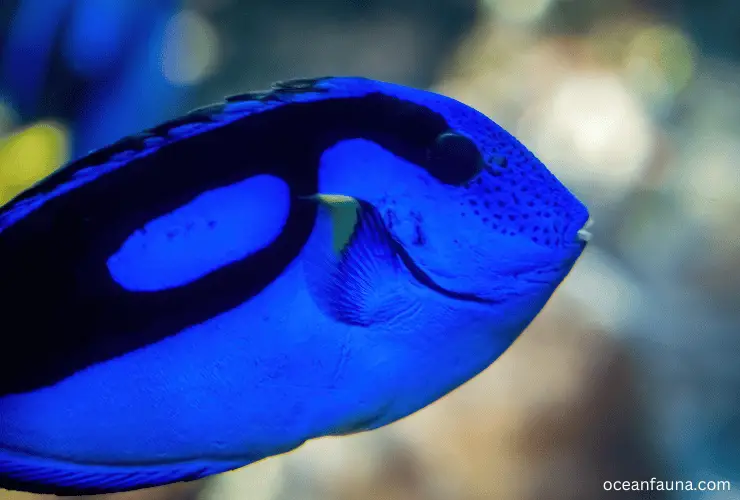
1 thought on “Blue Tang Fish: Diet, Habitat, Desccription & Facts”